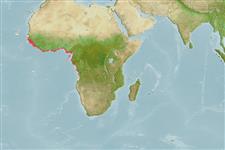Actinopterygii (ray-finned fishes) >
Perciformes (Perch-likes) >
Haemulidae (Grunts) > Plectorhinchinae
Etymology: Plectorhinchus: Greek, plektos = plaited + Greek, rhyngchos = snout (Ref. 45335).
Environment / Climate / Range
Ecology
Marine; brackish; benthopelagic; depth range 10 - ? m (Ref. 2683). Tropical, preferred 27°C (Ref. 107945); 15°N - 13°S
Eastern Atlantic: west African coast, from Senegal to Angola (Ref. 7376, 57395).
Size / Weight / Age
Maturity: Lm ? range ? - ? cm
Max length : 45.0 cm TL male/unsexed; (Ref. 5476); common length : 30.0 cm TL male/unsexed; (Ref. 5476)
Dorsal
spines
(total): 14;
Dorsal
soft rays
(total): 16;
Anal
spines: 3;
Anal
soft rays: 7. Diagnosis: body oblong, rather deep; dorsal profile strongly convex at level of dorsal-fin origin; snout at least as long as eye diameter; mouth oblique; lips very thick; chin with 4 pores, but without median pit; dorsal fin long; second anal fin spine the longest and stoutest; caudal fin rounded; ctenoid scales covering body and head (except snout) and interradial membranes of soft parts of dorsal and anal fins (Ref. 57395).
Coloration: uniformly brown, more or less dark; young individuals often with lighter spots on flanks (Ref. 57395).
Relatively rare species (Ref. 57395). Inhabits coastal waters (Ref. 3660, 57395), estuaries and coastal lagoons (Ref. 2683). Juveniles and sub-adults often in estuaries and lagoons (Ref. 2135, 57395), in freshwater (Ref. 2135), where sexual maturation begins (Ref. 57395).
Life cycle and mating behavior
Maturity | Reproduction | Spawning | Eggs | Fecundity | Larvae
Oviparous, distinct pairing during breeding (Ref. 205).
Roux, C., 1990. Haemulidae. p. 783-788. In J.C. Quero, J.C. Hureau, C. Karrer, A. Post and L. Saldanha (eds.) Check-list of the fishes of the eastern tropical Atlantic (CLOFETA). JNICT, Lisbon; SEI, Paris; and UNESCO, Paris. Vol. 2. (Ref. 6946)
IUCN Red List Status (Ref. 115185)
CITES (Ref. 94142)
Not Evaluated
Threat to humans
Harmless
Human uses
Fisheries: commercial
More information
ReferencesAquacultureAquaculture profileStrainsGeneticsAllele frequenciesHeritabilityDiseasesProcessingMass conversion
Tools
Special reports
Download XML
Internet sources
Estimates of some properties based on models
Phylogenetic diversity index (Ref.
82805): PD
50 = 0.5000 [Uniqueness, from 0.5 = low to 2.0 = high].
Bayesian length-weight: a=0.01950 (0.00846 - 0.04494), b=2.96 (2.76 - 3.16), in cm Total Length, based on LWR estimates for this (Sub)family-body shape (Ref.
93245).
Trophic Level (Ref.
69278): 3.7 ±0.6 se; Based on size and trophs of closest relatives
Resilience (Ref.
69278): Medium, minimum population doubling time 1.4 - 4.4 years (Preliminary K or Fecundity.).
Vulnerability (Ref.
59153): Moderate vulnerability (37 of 100) .
